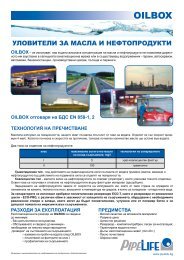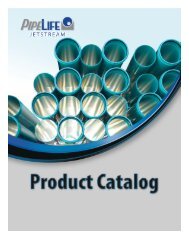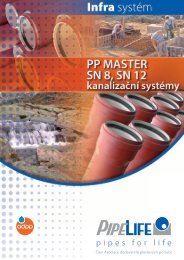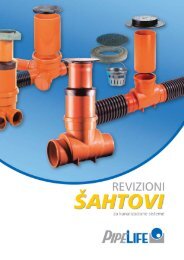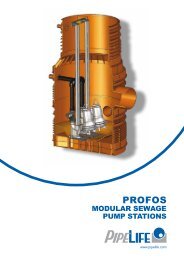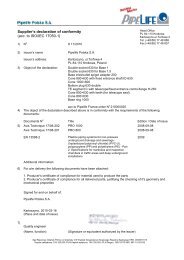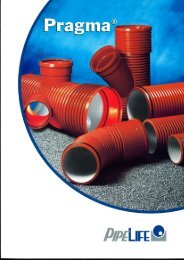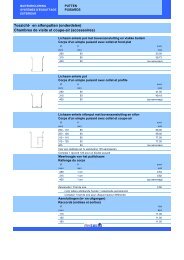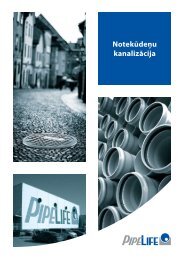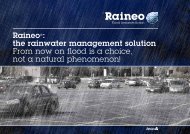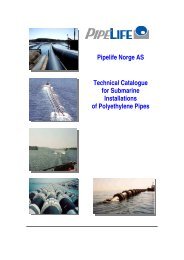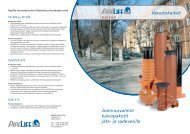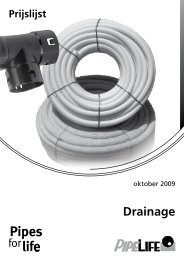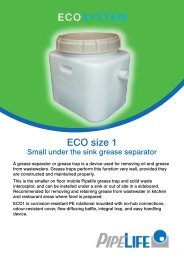Design manual
Design manual
Design manual
Create successful ePaper yourself
Turn your PDF publications into a flip-book with our unique Google optimized e-Paper software.
2. Percolation test – EPA (American) method<br />
A hole 15 cm in diameter is filled with water to<br />
the height of 30 cm. After presoaking (similar<br />
to the Polish method) the drop in water<br />
level from 30 cm to 27.5 cm is timed. The<br />
percolation rate, measured in min./25 mm,<br />
is the basis for determining permeability and<br />
filtration rate.<br />
12.3. Hydraulic conductivity<br />
for various types of soil<br />
3. Hydraulic conductivity<br />
In order to be suitable for rainwater<br />
infiltration, hydraulic conductivity of the<br />
soil must be 10 -3 m/s – 10 m/s.<br />
12.4. Guidelines on rainwater infiltration<br />
into the ground<br />
Infiltration systems are usually designed<br />
without drainage. It is possible, however, for<br />
the infiltration system to be equipped with<br />
an emergency overflow, through a settling<br />
chamber to another receptacle of rainwater,<br />
such as a rainwater drainage system. Soil<br />
permeability, tank depth, number and thickness<br />
of drainage layers underneath and around<br />
the box system and groundwater level are<br />
particularly important when designing a solution<br />
of this type.<br />
The useful volume of the box system should be<br />
chosen based on the least favourable conditions,<br />
in practice for precipitation lasting from 15 min<br />
to 360 min. The amount of precipitation should<br />
be based on actual precipitation in the given<br />
2<br />
Water percolation rate<br />
[min./25 mm]<br />
region (data from the Institute of Meteorology<br />
and Water Management).<br />
Infiltration systems should be able to contain<br />
rainwater from the planned catchment area.<br />
The first wave of water from the drainage area<br />
contains the most impurities. For that reason a<br />
chamber with a settling tank should be installed<br />
upstream of the infiltration system in order to<br />
Soil type Permeability [min./cm] Filtration rate [cm/h]<br />
< 1 Gravel < 0.4 < 150<br />
5 Sand 2 30<br />
10 Fine sand 4 15<br />
15 Clayey sand 6 10<br />
20 Sandy clay 8 7.5<br />
30 Clay 12 5<br />
40 Clay 16 3.75<br />
80 Heavy silty clay 32 1.875<br />
120 Very heavy clay 48 1.25<br />
> 120 Silt > 48 > 1.25<br />
3<br />
Permeability<br />
Hydraulic conductivity<br />
Permeability type<br />
coefficient<br />
[m/s] [m/h] [m/d] [Darcy]<br />
Very good: rockfill, gravel, coarse<br />
and uniform sand<br />
> 10 -3 > 3.6 > 86.4 > 100<br />
Good: non-uniform and medium sand 10 -4 - 10 -3 0.36 - 3.6 8.64 - 86.4 10 - 100<br />
Medium: fine sand, loess 10 -5 - 10-4 0.036 - 0.36 0.864 - 8.64 1 - 10<br />
Poor: silty and clayey sand, loam, sandstone 10 -6 - 10 -5 0.0036 - 0.036 0.0864 - 0.864 0.1 - 1<br />
Semipermeable rock: clay, aggregate mud,<br />
mudstone, sandy silt<br />
10 -8 - 10 -6 0.000036 - 0.0036 0.000864 - 0.0864 0.001 - 0.1<br />
Impermeable rock: silt, claystone, compact<br />
silty clay, silty marl<br />



